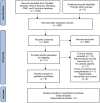Sarcopenic obesity is significantly associated with poorer overall survival after liver transplantation: a systematic review and meta-analysis
- PMID: 39737154
- PMCID: PMC11684403
- DOI: 10.3389/fnut.2024.1387602
Sarcopenic obesity is significantly associated with poorer overall survival after liver transplantation: a systematic review and meta-analysis
Abstract
Background: Sarcopenia has been shown to worsen survival after liver transplantation. However, it remains unclear whether coexisting sarcopenia and obesity, so-called sarcopenic obesity (SO), may also synergistically increase their adverse effects. This meta-analysis aimed to evaluate whether pre-transplant SO independently predicts survival in this population.
Methods: We conducted this study according to the Preferred Reporting Items for Systematic Review and Meta-Analyses guidelines. The PubMed, Embase, Web of Science, Wanfang, CNKI, and Cochrane databases were searched up to 15 October 2023, for studies with any study design evaluating the relationship between SO and post-transplant survival in patients undergoing liver transplantation. We used ROBINS-E to assess the study quality. The primary outcome was all-cause mortality at any length of follow-up. We calculated pooled odds risks (ORs) or hazard risks (HRs) with 95% confidence intervals (CIs). Heterogeneity was quantified with I 2 statistics. Subgroup analyses and publication bias evaluations were also conducted.
Results: We included nine cohort studies with 2,416 patients. These studies were moderate to high quality. Pre-liver transplant patients commonly experience SO, with a mean prevalence as high as 34%. Overall, patients with SO exhibited a significantly higher overall mortality than patients without SO, as demonstrated by pooled studies using both univariate analysis [HR = 1.76, 95%C 1.33-2.33, p < 0.0001] and multivariate analysis (HR = 2.33, 95%CI 1.34-4.04, p = 0.003). Similar results were also found when comparing patients with or without SO at 1, 3, and 5 years of follow-up (OR = 1.86, 95%CI 1.22-2.83; OR = 1.83, 95%CI: 1.27-2.64; and OR = 1.54, 95% CI 1.02-2.34, respectively). In addition, subgroup analysis based on studies that reported HRs of both sarcopenia and SO indicated both had independent negative effects on post-transplant survival.
Conclusion: Our meta-analysis showed that SO occurs frequently in liver transplant patients. SO is associated with an increased risk of mortality in such patient populations.
Systematic review registration: https://doi.org/10.37766/inplasy2024.2.0069 [inplasy2024.2.0069].
Keywords: liver transplantation; meta-analysis; obesity; sarcopenic obesity; survival.
Copyright © 2024 Huang, Zhu and Yu.
Conflict of interest statement
The authors declare that the research was conducted in the absence of any commercial or financial relationships that could be construed as a potential conflict of interest.
Figures







Similar articles
-
Impact of sarcopenia and sarcopenic obesity on survival in patients with primary liver cancer: a systematic review and meta-analysis.Front Nutr. 2023 Oct 19;10:1233973. doi: 10.3389/fnut.2023.1233973. eCollection 2023. Front Nutr. 2023. PMID: 37927508 Free PMC article.
-
Pre-transplant Sarcopenic Obesity Worsens the Survival After Liver Transplantation: A Meta-Analysis and a Systematic Review.Front Med (Lausanne). 2020 Dec 16;7:599434. doi: 10.3389/fmed.2020.599434. eCollection 2020. Front Med (Lausanne). 2020. PMID: 33392221 Free PMC article.
-
Prevalence of sarcopenic obesity in patients with diabetes and adverse outcomes: A systematic review and meta-analysis.Clin Nutr ESPEN. 2023 Dec;58:128-135. doi: 10.1016/j.clnesp.2023.09.920. Epub 2023 Sep 29. Clin Nutr ESPEN. 2023. PMID: 38056996
-
Sarcopenia and sarcopenic obesity are significantly associated with poorer overall survival in patients with pancreatic cancer: Systematic review and meta-analysis.Int J Surg. 2018 Nov;59:19-26. doi: 10.1016/j.ijsu.2018.09.014. Epub 2018 Sep 25. Int J Surg. 2018. PMID: 30266663
-
Association of sarcopenic obesity with the risk of all-cause mortality among adults over a broad range of different settings: a updated meta-analysis.BMC Geriatr. 2019 Jul 3;19(1):183. doi: 10.1186/s12877-019-1195-y. BMC Geriatr. 2019. PMID: 31269909 Free PMC article.
References
Publication types
LinkOut - more resources
Full Text Sources

